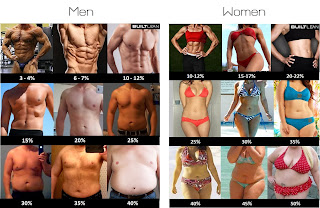 The chart to the right is from the American Council on Exercise (ACE) and is one of the most commonly used body fat charts.
The chart to the right is from the American Council on Exercise (ACE) and is one of the most commonly used body fat charts.As you can see, women have a higher body fat percentage relative to men for a given level. Women have more fat because of physiological differences such as hormones, breasts, and sexual organs. In addition, women need a higher amount of body fat for ovulation.
"Essential fat” is the minimum amount of fat necessary for basic physical and physiological health. We all have different shapes, sizes, and fat distribution profiles, but I think the chart above is a good starting point.
The limitation of the ACE chart is that while it takes into account gender differences, it does not take into account your age, which is why I included the next two charts.

In case you don’t understand how to read this chart, the age column is on the left, the body fat percentages are in the chart, and the colours represent Lean, Ideal, Average, and Above Average ranges. So if you are a 30 year old man, a body fat percentage between 10% and 16% is considered “Ideal” and between 18% and 22% is considered “Average”, and so on.
As you will have noticed as your age increases, your acceptable body fat increases as well.
the reason for this is older individuals tend to have a lower body density for the same skinfold measurements, which is assumed to indicate a higher body fat percentage. Older, athletic individuals, however, might not fit this assumption because their body density may be underestimated.
There are 3 types of fat: subcutaneous (under the skin), visceral (around the organs), and intramuscular (in between muscle, like a marbled steak). The amount of subcutaneous body fat you have may stay the same, but the visceral and intramuscular fat may increase as you age. For a visual representation of a given body fat level, you can check out this picture:
The most accurate method to measure body fat is with a body fat analyser this works by passing a low level electric current through the soles of your feet, since the different constituants of your body conduct differently the analyser can determine your Body fat, the levels of hydration and bone density.
How can this be used to set your goal ??
to give you an approximation of how much weight you need to aim for a simple calculation can be carried out, these figures are based on my own statistics and measurements.
I used a bodyfat analysier for the measurements.
my weight started at 107 Kgs ( 236 lb) my body fat was 34% a simple calculation that's 37.45 Kg's ( 82.5lb's) of fat
a healthy maximum is 18-24...%.
a target of 89Kgs (196lb) would put me on the edge of the upper limit but at least gave me a starting point.
As my weight fell what this started to make more sense, my weight is now 82 Kg's (180 lb's)
my body fat content is 20.1%
So does the math work?
107Kgs @ 34% = 37.45 Kg's
82Kgs @ 20.1% = 16.5 Kg's
total fat lost = 20.95 Kg's
actual loss 25 Kg's this is a discrepancy of 4 Kg's this can easily be attributed to the body being smaller ( less skin and water etc)
So as a starting point and for setting a target it's close enough.
I have exceeded my initial target and have re evaluated my new aim is 15% a target that with hard work should be achievable.

to view full size image click here
http://www.healthygrad.org/wp-content/uploads/2013/01/body-fat-percentage-men-women.png


in fact, obesity or body fat has relate with difficult pregnancy
ReplyDeleteI very much enjoyed reading your blog post. It has helped a lot.
ReplyDeleteIf possible, as more knowledge comes your way, I hope you could update to share more information with us. It is very helpful.
I also know of more informational sources that could benefit your readers, please find links below
Proteine Apotheke